24 June, 2001
Sunday
Sleep in day. The main reason for that is not that it is Sunday and our
day off but that breakfast isn't served till 11:30! Glen knows hungry
field workers are not happy (or productive) field workers so we getting a
late start but it was nice to have the morning!
We're starting the second part of this season's work today. Glen wants to
gather data on species growth and variation within his plots and see if
the different treatments he has going in each plot will have an effect on
plant productivity. We will be doing carbon flux measurements on the
individual species in the plots also to see if significant differences
exist in species.
To do a species count in tundra vegetation is painstaking, not because it
is difficult, but because the plants you have to count are so small and
they are interspersed with many similar looking species. Imagine mixing
20 different species (types) of grass seeds together, planting them and
then going back out when your yard is nice and green and finding only the
rye grass plants in 18, 2 foot by 2 foot circles randomly picked around
your yard. That is what we started doing today.
Glen selected out a parcticular grass species, Dupontia fischeri, along
with 3 other vascular plant species, which we will be counting, measuring
and relocating twice this season to document population and growth
changes. These species were chosen because they are present in most all
the plots in varying numbers. He did not want to mark or flag the
vegetation, which in itself might change the plots and skew the data
possibly, so he devised a system to record the location of the designated
plants using a compass and a measuring devise.
Michelle and I were given the task of coming up with making the measuring
tool that would accomplish Glen's goal, and as you see from below, the
KISS principle worked once again. The string is secured on a pivot point
overlaid on a 360-degree compass. Each knot is a centimeter apart. We
record the degrees and the distance of the plants we want to study, record
the information, and then we'll return to the same ones whenever we have
to check growth rates and numbers. We worked most of the afternoon on our
stomachs! These plants are short plus we had to separate the different
species. In 3 hours we had 2 plots completed! Hopefully, with practice,
the times will get shorter as we get familiar with the identification.
The group from U. of Michigan, across the hall, is doing this type of work
all summer!
Michelle is also responsible for designing and carrying out a project
while she is up here in Barrow. Her project concerns looking into fungal
infection rates of the root system of 2 specific species of scrubs, Salix
roundofloria and Salix pulcra. We located 4 areas near Glen's site,
mainly to cut down on the walking, and marked them out with stakes and
string. These areas are called meter squares and as their name implies
they are one meter to a side. Within each square Michelle will take two
soil core samples beneath the plants. This sample is either cut out or,
when possible, a soil can is placed on the surface and pushed down to fill
with a sample. Michelle is also collecting samples of each species because
she wants to chemically test the roots in the lab to see if they have any
fungal growth.
Why is so much time being devoted to plants up here? The CO2 in the
atmosphere is interacting with the vegetation. It is thought that when
the moisture content of soil is high the less ability the plants,
including the roots, have to undergo respiration. Less respiration
occurring means a lesser amount of CO2 is released into the air. One
would say that is beneficial presently because we want to cut down on the
amount of this gas but the less amount of plant production occurs under
this condition also. Less plant production, less amounts of CO2 are being
taken out of the air and used (stored) by plan
Michelle should have had a clue to how hard cleaning the root of this
species would be when she had to cut a chunk of plant (like the center
piece of a sheet cake) removing it with all its roots in tact from the
tundra. After working on the cleaning process under water in the lab
tonight for a few hours she found that the cleaning process was going to
be difficult. Luckily there are people here who have done this and they
gave her some helpful hints. She'll have to shake the soil from the roots
in a shaker set up. The soil, really peat, and the roots are so entwined
that no amount of pulling can separate the two. Nothing is as easy as it
looks at first we're finding out.
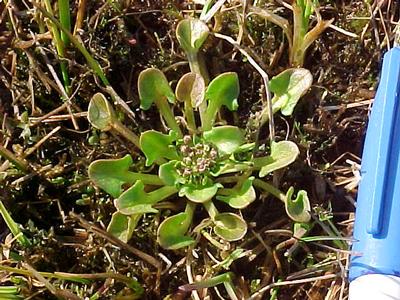
I found this plant while helping Michelle look for her species. Cochlearia officinalis, scurvygrass. It looks different here than my specimen a few days ago. The pen showes you just how tiny this plant is. We all had sore backs after the plant patrol!
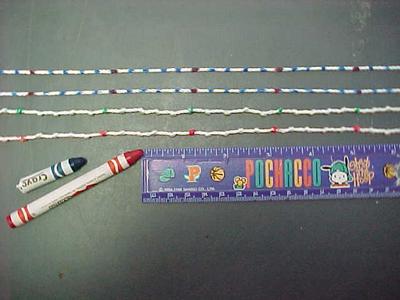
In the field you get creative when need arises and use materials that are available. We are beginning Glen's plant species count and needed measureing devises. After much R and D we developed these high tech, painstakingly calibrated instruments. (Pat. pending! Don't try this at home!))
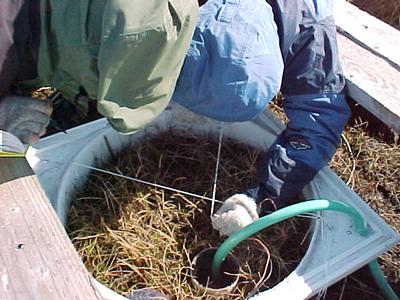
How did our calibrated measuring instruments work? Look at the results, two researchers successfully counting (and being able to relocate) several species of tundra grasses.
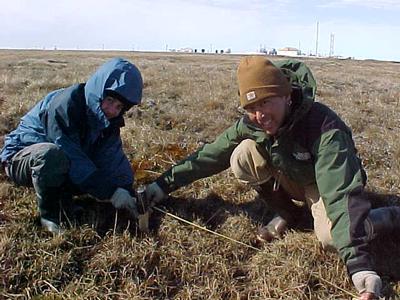
Glen and Michelle stringing out Michelle's meter square plots. Michelle located parcticular plant species and then marked them off. She will be taking growth measurements and investigating root development.

Here is what Salix pulchra looks like on the ground. Notice the gray, furry flowers, a give away for the willow family. These are hard to spot!
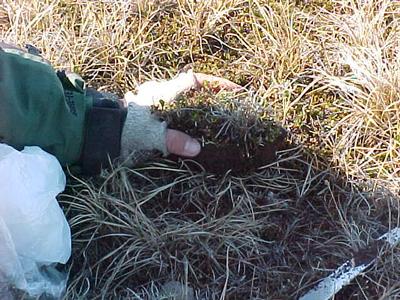
This is the other shrub, Salix rotundifolia, Michelle is studying. The knife is there so she can cut a piece of tundra out without disturbing the roots. Many ot the plants here are clones, by that I mean each surface plant does not have its own individual root but grows off of the underground root system. Thus on the surface the plants may look numerous but in reality the plant has a common root and has to be extracted from the soil in a clump.
Contact the TEA in the field at
.
If you cannot connect through your browser, copy the
TEA's e-mail address in the "To:" line of
your favorite e-mail package.
|
